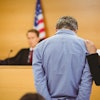
A 55-year-old man, gainfully employed as a municipal worker, presented to a multidentist general practice for an examination and cleaning after several years without seeing a dentist. His only specific complaints were that he had some posterior teeth, one each on the upper and the lower right, which he knew to have large cavities for some time, although they caused him no pain or other symptoms.
Upon arriving at the office, he was asked to and did complete typical first-visit paperwork, including a medical history form, which he signed and dated.
Once brought into a treatment room, he was seen by a general dentist. This dentist had received his license only a week earlier after completing a general practice residency during the year following dental school graduation.

This dentist, who later became our client, reviewed the medical history form with the patient, whose only positive written medical history was "high blood pressure, controlled." The patient repeated those exact words to the dentist, and he denied all other health conditions, both on the comprehensive form and in discussion with the dentist.
A full-mouth series of x-rays, along with a clinical examination, revealed severely broken-down and hopeless teeth Nos. 3 and 31, but nothing else was needed, other than a cleaning to remove notable calculus.
Initially, the dentist performed a full-mouth prophylaxis using a Cavitron and hand scalers. He then asked the patient whether he wished to have the two teeth extracted that day or return another day for the surgery. The patient wanted the extractions that day and signed a typical extraction consent form, which was witnessed by the dentist and an assistant.
The dentist gave a mandibular block and maxillary infiltrations, using a total of two carpules of 2% lidocaine with 1:100,000 epinephrine. The dentist easily extracted tooth No. 3 and then turned his attention to the lower right, where he began to extract the second molar. That tooth crumbled when an elevator was applied, leaving only root fragments solidly encased in bone.
The dentist elevated an envelope flap on the buccal and was about to begin to drill the buccal alveolar bone so as to create a trough, when the patient became rigid with tonic-clonic movements that appeared typical of a grand mal seizure. These lasted no more than a minute. The patient did not respond to the dentist when he spoke to the patient, so he asked his assistant to call 911, which she immediately did.
An ambulance crew arrived in approximately 15 minutes. In the interim, the dentist placed an oxygen mask over the patient's nose and mouth, as the patient continued to breathe on his own, although he remained nonresponsive. The emergency medical technicians took the patient's blood pressure and found it to be 145/90. This was the first blood pressure reading, as the office had no blood pressure equipment.
Oxygen saturation readings demonstrated more than adequate levels. The patient was transported to a local hospital. At the hospital, his blood pressure remained stable, but he never regained consciousness before his death six days later. An autopsy was performed, which determined the cause of death to be cardiopulmonary arrest, but the reason for that was not determined by the medical examiner.
Legal stance
The patient's estate filed suit against our client claiming wrongful death of the patient as a result of dental malpractice. The stated allegations of negligence included five points:
- The dentist's failure to obtain a complete medical history
- His failure to take a preprocedure blood pressure reading
- His failure to manage the patient appropriately following the seizure-like event
- His giving an inappropriate type of local anesthesia in an improper manner
- His performing a procedures for which he was not adequately trained and experienced, all of which caused the patient's death
As we viewed the allegations when we received the defense of the case, it all came down to claims that the dentist should have taken the patient's blood pressure and should not have used epinephrine in the local anesthetic. Although the dentist was not well-experienced (which would probably not look good to a jury), he did have adequate training, and he was acting within the scope of dental practice. Additionally, we viewed his actions following the event, in consultation with our expert, as proper.
The patient's wife, as representative of the estate, was deposed, but she had no firsthand knowledge of what occurred in the dental office. Our client was also deposed, and he testified in accordance with the facts discussed above as well as his injection technique, which was proper.
He testified that, even if the office did have blood pressure equipment, he would not have taken the patient's pressure, because the patient told him that it was under control, although he never asked and the patient did not say whether it was controlled with or without medication. We saw this as a weakness in our defense.
We also took the deposition of the primary physician who cared for the patient in the hospital. After thoroughly reviewing everything that had taken place, both before hospital admission and during hospitalization, she was unable to add anything more in terms of the cause of the seizure-like event or the patient's death than the autopsy revealed.
Issues raised
Two issues were raised during the legal process:
- Wrongful death in the dental setting: A claim of wrongful death means that a person's death was wrongfully -- negligently -- caused. In the dental practice realm, this means that dental malpractice was that negligence. In reality, any aspect of the treatment that is found to be below the standard of care will suffice to fill that requirement.
- What is a valid claim of dental malpractice: It is a misconception among many dentists that they are liable for malpractice if they do anything improper during the course of their dental care. This is incorrect: In order to make a case in dental malpractice, a plaintiff must prove that there was treatment that fell below the standard of care and that such improper treatment was the cause of the injury claimed, which in this case was death.
Summary judgment motion practice
This procedure, which we have discussed in previous case reports, seeks to have the entire case, or portions of it, dismissed by the judge, in advance of a jury trial. The standard employed is whether there exist legitimate questions of fact for a jury to decide. If not, then the judge may choose to decide certain issues, thereby taking them out of the hands of jurors.
“Dentists should focus on the quality of their work and decisions and put aside the rest.”
It was clear to us that plaintiff's counsel would quite readily be able to obtain an opinion from a dentist that the standard of care requires that a dentist take the blood pressure reading of a patient with a known history of high blood pressure, whether reported as controlled or not, and possibly that epinephrine-containing local anesthetic should not be used in any such patient.
So we focused our approach solely on the issue of whether whatever negligence there may have been directly caused the patient's office event and subsequent death. The burden of proof lies with the plaintiff to prove that there was negligence and also that such negligence caused the event and the patient's death.
In our motion papers to the court, we did not even touch the appropriateness, or lack, of the dentist's treatment. Instead we argued, with the backing of the treating physician's testimony and the autopsy report, that the cause of the event was unknown; because the cause could not be linked directly to the dentist's actions, there was no way for the plaintiff to prove that the dentist was liable for the office event or eventual death.
Motion unopposed
As we had hoped and expected, the plaintiff's (wife's) attorney had no greater insight or information into the cause of death than we did. So, her attorney was unable to obtain the statement of any medical professional who could directly tie our client's actions and/or inactions to what came to pass to the patient. Even if he had procured such a statement, it would likely have been deemed too speculative. Our motion was granted as unopposed, and the case was dismissed.
While many dentists will view the pretreatment actions of our client as inadequate and wrong, and many may also intuitively believe that there was a connection, malpractice litigation requires medical proof of that connection. What seems to have happened here from the litigation perspective is that the plaintiff's attorney had the same intuition at the start of the case but was unable to demonstrate it in the legal setting.
Practice tips
- Presume causation: Although causation was not provable here, that is an unusual circumstance, and the dentist is wise to presume that improper dental practice will likely be able to be shown as the source of a bad outcome. So, even though a bad result requires negligence to cause it during litigation, dentists should focus on the quality of their work and decisions and put aside the rest. If litigation ensues, lawyers will use all appropriate tools at their disposal to seek case dismissal.
- Record keeping: We use this opportunity to reiterate the importance of records. What may seem insignificant at the time may end up as the pillar of a legal defense. For example, if a blood pressure reading is taken, be sure to enter it into the patient's chart; it could be your best friend in court.
William S. Spiegel, Esq., is a partner at the law firm Spiegel Leffler in New York City. He is a former assistant corporation counsel to the City of New York -- Medical Malpractice Division.
Marc R. Leffler, DDS, Esq., is also a partner at Spiegel Leffler. He received his dental degree from Columbia University, completed a residency in oral and maxillofacial surgery at New York University, and is a diplomate of the American Board of Oral and Maxillofacial Surgery.
Disclaimer: Nothing contained in this column is intended as legal advice. Our practice is focused in the state of New York, and there are variations in rules of practice, evidence, and procedure among the states. This column scratches the surface on many legal issues that could call for a chapter unto themselves. Some of the facts and other case information have been changed to protect the privacy of actual parties.
The comments and observations expressed herein do not necessarily reflect the opinions of DrBicuspid.com, nor should they be construed as an endorsement or admonishment of any particular idea, vendor, or organization.


















